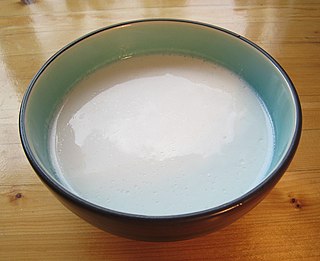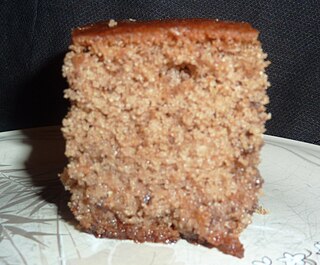Related Research Articles

Dessert is a course that concludes a meal. The course consists of sweet foods, such as cake, biscuit, ice cream and possibly a beverage such as dessert wine and liqueur. Some cultures sweeten foods that are more commonly savory to create desserts. In some parts of the world there is no tradition of a dessert course to conclude a meal.
Jamaican cuisine includes a mixture of cooking techniques, flavours and spices influenced by Amerindian, West African, Irish, English, French, Portuguese, Spanish, Indian, Chinese and Middle Eastern people who have inhabited the island. It is also influenced by the crops introduced into the island from tropical Southeast Asia, many of which are now grown locally. A wide variety of seafood, tropical fruits and meats are available.

Coconut milk is an opaque, milky-white liquid extracted from the grated pulp of mature coconuts. The opacity and rich taste of coconut milk are due to its high oil content, most of which is saturated fat. Coconut milk is a traditional food ingredient used in Southeast Asia, Oceania, South Asia, and East Africa. It is also used for cooking in the Caribbean, tropical Latin America, and West Africa, where coconuts were introduced during the colonial era.

A grater, also known as a shredder, is a kitchen utensil used to grate foods into fine pieces.

Rice pudding is a dish made from rice mixed with water or milk and commonly other ingredients such as sweeteners, spices, flavourings and sometimes eggs.

Gulab jamun is a sweet confectionary or dessert, originating in the Indian subcontinent and a type of mithai popular in India, Pakistan, Nepal, the Maldives and Bangladesh, as well as Myanmar. It is also common in nations with substantial populations of people with South Asian heritage, such as Mauritius, Fiji, Gulf states, the Malay Peninsula, Great Britain, South Africa, and the Caribbean countries of Jamaica, Trinidad and Tobago, Guyana, and Suriname.

Cơm rượu also known as rượu nếp cái is a traditional Vietnamese dessert from Southern Vietnam, made from glutinous rice.
Asham is a corn-based Caribbean dessert. It is thought to have originated in Africa, with the name asham derived from the Akan word o-sĭám meaning "parched and ground corn". Other names include Brown George (Jamaica), asham (Grenada), sansam and chilli bibi (Trinidad), caan sham, casham and kasham (Belize).

Gizzada, also referred to as pinch-me-round, is an indigenous pastry in Jamaican cuisine. The tart is contained in a small, crisp pastry shell with a pinched crust and filled with a sweet and spiced coconut filling.

Toto is a small coconut cake in Jamaican cuisine served as a snack or dessert. The cake is typically prepared with shredded coconut, brown sugar, flour, baking soda and powder, and coconut milk. It may also be added with some flavorings such as allspice, nutmeg, ginger, and salt.
Cocktion is a dessert in Jamaican cuisine made from parched corn and sugar rolled into balls and sometimes colored.

A rum cake or black cake is a type of dessert cake which contains rum. In most of the Caribbean, rum cakes are a traditional holiday season dessert, descended from the holiday puddings. Traditionally, dried fruit is soaked in rum for months and then added to dough prepared with sugar which has been caramelized by boiling in water. The result, also known as "black cake", is similar to a fruitcake, with a lighter texture.

Coconut cake is a popular dessert in the Southern region of the United States. It is a cake frosted with a white frosting and covered in coconut flakes.

Kabak tatlısı is a pumpkin dessert in Turkish cuisine. It is made by cooking peeled and cut pumpkin that has had sugar sprinkled on it. Milk can also be used. The dish is topped with chopped walnuts with tahini or kaymak. It is a winter-time seasonal dessert. The texture has been described as resembling taffy.
Phoenicia dessert is a type of Lebanese cookie. The dessert was named after the ancient Phoenicians.
Coconut drop, also known as drops, is a Jamaican cuisine dessert made with cut up coconut meat, ginger and brown sugar.

Karydopita is a Greek dessert cake made primarily from walnuts and covered in a sweet syrup. Its name is a compound word which derives from "karýdia" and "pita".
References
- 1 2 Frederic Gomes Cassidy, Robert Brock Le Page Dictionary of Jamaican English page 72